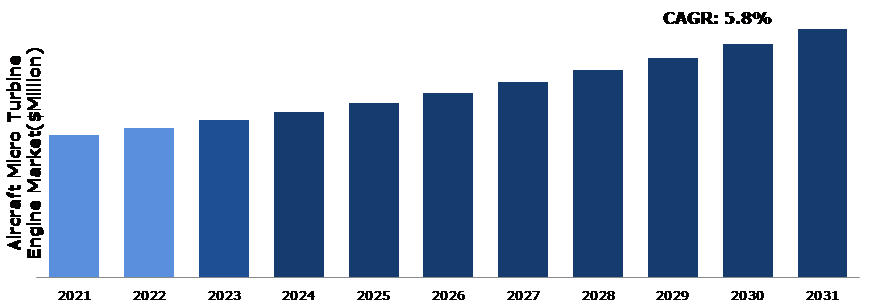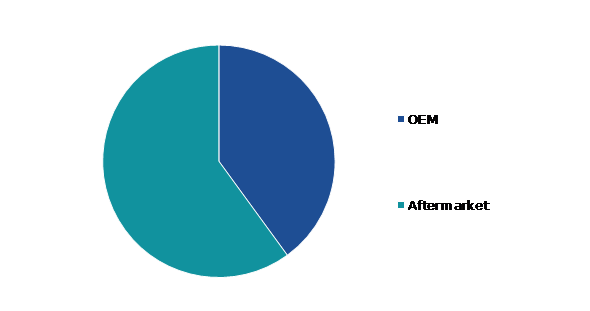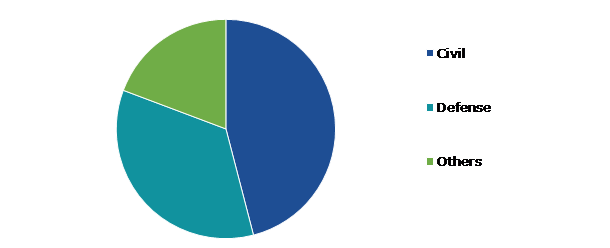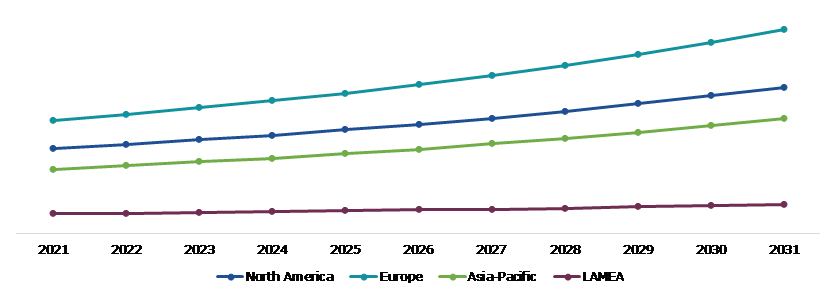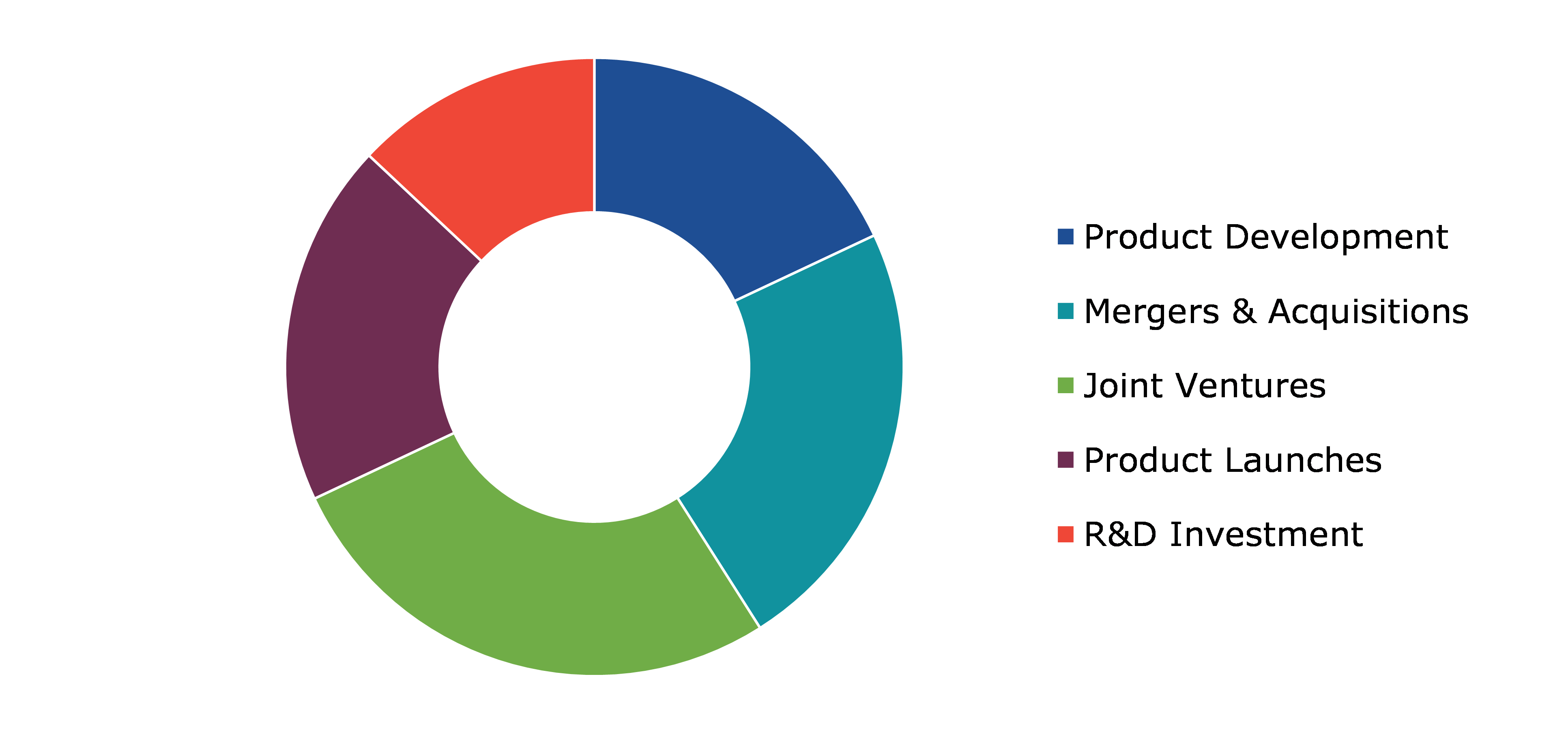Aircraft Micro Turbine Engine Market Report
RA00192
Aircraft Micro Turbine Engine Market by Engine Type (Turboshaft and Turbojet), Distribution Channel (OEM and Aftermarket), Application (Civil, Defense, and Others), and Regional Analysis (North America, Europe, Asia-Pacific, and LAMEA): Global Opportunity Analysis and Industry Forecast, 2022-2031
Global Aircraft Micro Turbine Engine Market Analysis
The Global Aircraft Micro Turbine Engine Market Size was $2,331.80 million in 2021 and is predicted to grow with a CAGR of 5.8%, by generating a revenue of $4,074.90 million by 2031.
Global Aircraft Micro Turbine Engine Market Synopsis
The micro turbine is a relatively new distributed generation technology that is finding application in stationary energy generation. Micro turbines are air-breathing jet engines that consist of an air inlet, compressor, combustion chamber, and turbine. They offer greater efficiency compared to other technologies and have been optimized for a realistic combination of turbine inlet temperature, recuperation rate, and pressure ratio. The stimulated electrical efficiency of micro turbines is around 45%, making them a promising solution for decentralized heat and electricity production. Improved efficiency of combined heat and power systems using micro turbines will significantly decrease emissions and operating costs. Furthermore, cost-effective, compact, and environmentally friendly micro and small-scale turbine systems with high electrical efficiency have an opportunity to successfully compete against reciprocating engines. As the demand for sustainable and efficient energy solutions increases, micro turbines are expected to play an increasingly important role in the decentralized energy landscape.
The major challenges for the micro turbine engine sector are its high cost when compared to regular piston engines. Its cost is attributed to the usage of high-quality materials, precision manufacturing, and the requirement for specialized components. The turbines are made up of precision components that require advanced manufacturing techniques to achieve the required tolerances. The manufacturing process involves the use of high-quality materials, which are often expensive, leading to higher production costs. In addition, the requirement for specialized components for micro turbines further increases the cost of production.
Microturbine engines have various benefits over other types of engines, making them a suitable power source for unmanned aerial vehicles (UAVs). Microturbines have a better power-to-weight ratio than reciprocating engines, making them perfect for UAVs that need to be lightweight and agile. In addition, microturbines are highly efficient, which means they can give longer flight periods and better range for UAVs. Microturbines have fewer moving parts than reciprocating engines, which minimizes maintenance requirements and boosts reliability.
According to regional analysis, the Europe aircraft micro turbine engine market forecast accounted for a dominant market share in 2021. The market for aircraft micro turbine engines in Europe is expected to expand significantly in the upcoming years, due to technological advancements, rising demand for more efficient and dependable engines, and the expansion of the region's aviation and UAV markets.
Aircraft Micro Turbine Engine Overview
Aircraft micro turbine engines are a type of air-breathing jet engine that is designed for use in aircraft. These engines are relatively small in size and offer several advantages over traditional reciprocating engines, such as higher power-to-weight ratios, greater fuel efficiency, and lower emissions. A micro turbine engine typically consists of an air inlet, a compressor, a combustion chamber, and a turbine. Air is drawn into the engine through the air inlet and compressed by the compressor. Fuel is then injected into the compressed air and ignited in the combustion chamber, producing a high-temperature, high-pressure gas that flows through the turbine. The turbine extracts energy from the gas flow and converts it into rotational energy that drives the compressor and any attached machinery, such as a generator or a propeller.
COVID-19 Impact on Global Aircraft Micro Turbine Engine Market
The COVID-19 impact on aircraft micro turbine engine market had a severe influence on the global aircraft micro turbine engine market. The drop in air travel and the resulting decrease in demand for new aircraft has led to a decrease in demand for microturbine engines as well. The pandemic caused a delay in new aircraft orders because airlines and aircraft manufacturers were unsure about future demand for air travel. Therefore, several aircraft manufacturers have had to postpone or cancel plans to deploy new aircraft that would require microturbine engines. Also, the pandemic impacted the global supply chain for airplane components, especially microturbine engines. Several manufacturers faced delays in obtaining parts and materials required to make aircraft engines, resulting in manufacturing delays and supply shortages. This has further reduced the demand for microturbine engines during the pandemic.
Rising Demand for Electric and Hybrid-Electric Aircraft to Drive the Market Expansion
Microturbine engines are not electrically powered engine, but they can play a crucial role in powering electric generators on board hybrid-electric aircraft. As the aviation industry increasingly focuses on reducing carbon emissions and promoting sustainable air travel, hybrid-electric aircraft have gained considerable interest in recent years. These aircrafts use a combination of electric and traditional fossil-fuel engines, which helps reduce emissions and improve fuel efficiency. The compact size and high-power density of microturbine engines make them an ideal choice to serve as auxiliary power units (APUs) on hybrid-electric aircraft. APUs are typically used to provide electrical power to the aircraft's systems when the main engines are not running, such as during ground operations or in the event of an emergency. Microturbine engines can be used to power electric generators that provide electricity to the aircraft's systems and battery packs, allowing for a more efficient and reliable power source. The rising interest in hybrid-electric aircraft could therefore provide a boost to the aircraft micro turbine engine market.
To know more about global aircraft micro turbine engine market drivers, get in touch with our analysts here.
The Limited Market Penetration of Aircraft Microturbine Engine to Hinder the Market Growth
The growth of the microturbine engine market for aircraft is expected to face challenges due to its limited market penetration. However, adoption of microturbine engines in the larger commercial aviation market has been limited, making it challenging for manufacturers to achieve economies of scale and remain competitive in terms of cost. The relatively small market size also makes it difficult to justify the high development costs associated with microturbine engines for commercial aviation. These factors are anticipated to hinder the aircraft micro turbine engine market growth in the upcoming years.
Increase in Demand for Urban Air Mobility to Drive Excellent Opportunities in the Market
Urban air mobility (UAM) is becoming more popular as a potential approach to reduce transportation congestion in urban areas. With this trend, there is an emerging need for small, electric vertical takeoff and landing (eVTOL) aircraft that can transport passengers and products efficiently within and between cities. Microturbine engines can provide the high power-to-weight ratios and lengthy endurance times needed for these aircrafts. Microturbine engines have various advantages for eVTOL aircraft, including great fuel efficiency, compact size, and minimal noise emissions. They can also provide a dependable and efficient supply of power to support the electric propulsion systems used in these aircrafts. Therefore, microturbine engines could become a feasible solution for the UAM and it is expected to increase rapidly. All these factors are anticipated to create several opportunities for the key players operating in the aircraft micro turbine engine market growth.
To know more about global aircraft micro turbine engine market opportunities, get in touch with our analysts here.
Global Aircraft Micro Turbine Engine Market, by Engine Type
Based on engine type, the market has been divided into turboshaft and turbojet. Among these, the turboshaft sub-segment accounted for a dominant market share in 2021.
Global Aircraft Micro Turbine Engine Market Size, by Engine Type, 2021
Source: Research Dive Analysis
The turboshaft sub-segment accounted for a dominant market share in 2021. Turboshaft engines are a type of gas turbine engine that are designed to produce rotational power output rather than jet thrust. They are used in a variety of applications, including helicopters, turboprop aircraft, and some small unmanned aerial vehicles (UAVs). In a turboshaft engine, air is compressed and mixed with fuel in the combustion chamber, where it is ignited to create high-pressure, high-temperature gases. These gases are then passed through a turbine, which extracts some of the heat energy and converts it into rotational motion to drive the output shaft.
Global Aircraft Micro Turbine Engine Market, by Distribution Channel
Based on distribution channel, the market has been divided into OEM and aftermarket. Among these, the aftermarket sub-segment accounted for a dominant market share in 2021.
Global Aircraft Micro Turbine Engine Market Share, by Distribution Channel, 2021
Source: Research Dive Analysis
The aftermarket sub-segment accounted for a dominant market share in 2021. The aftermarket segment of the aircraft micro turbine engine market trend is limited to the replacement of auxiliary power units (APUs) after their service life expires. The aftermarket segment of the microturbine engine market primarily focuses on replacing microturbines in older aircraft, including light aircraft, military UAVs, and advanced air mobility platforms. APU replacement is available only from micro turbine engine manufacturers. The aftermarket for micro turbine engines of light aircraft, military UAVs, and advanced air mobility aircraft is futuristic as many of these products have yet to be commercialized. Nonetheless, continued developments in micro turbine engine technology are projected to support the growth of the aftermarket segment.
Global Aircraft Micro Turbine Engine Market, by Application
Based on application, the market has been divided into civil, defense, and others. Among these, the civil sub-segment generated the maximum revenue in 2021.
Global Aircraft Micro Turbine Engine Market Growth, by Application, 2021
Source: Research Dive Analysis
The civil sub-segment accounted for a dominant market share in 2021. The civil application of aircraft microturbine engines includes both commercial and general aviation applications. These engines can be found in a wide range of aircraft, from small turboprop planes to big passenger jets and helicopters. Micro turbine engines are frequently used as auxiliary power units (APUs) in commercial aviation, supplying electrical power and air conditioning while the aircraft is on the ground. They can also be used as main power units for smaller regional aircraft, delivering higher fuel efficiency and lower emissions as compared to standard piston engines.
Global Aircraft Micro Turbine Engine Market, Regional Insights
The aircraft micro turbine engine market was investigated across North America, Europe, Asia-Pacific, and LAMEA.
Global Aircraft Micro Turbine Engine Market Size & Forecast, by Region, 2021-2031 (USD Million)
Source: Research Dive Analysis
The Market for Aircraft Micro Turbine Engine in Europe was the Most Dominant
Europe accounted for a dominant aircraft micro turbine engine market share in 2021.The rising demand for more efficient and dependable aircraft engines, together with the expansion of the region's aviation industry, is driving the growth of the aircraft micro turbine engine market in Europe. The increase in demand for tiny, lightweight, and fuel-efficient engines is one of the primary factors driving the regional market expansion. Micro turbine engines are well-suited for usage in small aircraft and unmanned aerial vehicles (UAVs) because of their excellent power-to-weight ratios and low fuel consumption. Also, the expansion of the UAV sector in European countries is likely to increase the demand for micro turbine engines in the region. These engines are often utilized in UAVs because of their small size, low weight, and great power output.
Competitive Scenario in the Global Aircraft Micro Turbine Engine Market
Investment and agreement are common strategies followed by major market players. For instance, in February 2023, the Czech Republic-based company PBS Velká Bíteš announced the release of a pyrotechnic ignition version of its most powerful engine, the PBS TJ150. This new version of the engine utilizes a pyrotechnic igniter to initiate combustion, which is expected to offer several benefits over traditional spark ignition. According to PBS Velká Bíteš, the use of pyrotechnic ignition can improve the reliability and reduce the weight of the engine. The TJ150 engine is primarily used in small unmanned aerial vehicles (UAVs), where reliability and weight are critical factors.
Source: Research Dive Analysis
Some of the leading aircraft micro turbine engine market analysis players are AeroDesignWorks GmbH, Elliott Company, General Electric Company, Honeywell International Inc., Kratos Defense & Security Solutions, Inc., PBS Group, Sentient Blue Technologies, Turbotech SAS, Williams International., and Micro Turbine Technology B.V.
| Aspect | Particulars |
| Historical Market Estimations | 2020 |
| Base Year for Market Estimation | 2021 |
| Forecast Timeline for Market Projection | 2022-2031 |
| Geographical Scope | North America, Europe, Asia-Pacific, and LAMEA |
| Segmentation by Engine Type |
|
| Segmentation by Distribution Channel |
|
| Segmentation by Application |
|
| Key Companies Profiled |
|
Q1. What is the size of the global aircraft micro turbine engine market?
A. The size of the global aircraft micro turbine engine market size was over $2,331.80 million in 2021 and is projected to reach $4,074.90 million by 2031.
Q2. Which are the major companies in the aircraft micro turbine engine market?
A. AeroDesignWorks GmbH, Elliott Company, and General Electric Company are some of the key players in the global aircraft micro turbine engine market.
Q3. Which region, among others, possesses greater investment opportunities in the future?
A. Asia-Pacific possesses great investment opportunities for investors in the future.
Q4. What will be the growth rate of the Asia-Pacific aircraft micro turbine engine market?
A. Asia-Pacific aircraft micro turbine engine market share is anticipated to grow at 6.0% CAGR during the forecast period.
Q5. What are the strategies opted by the leading players in this market?
A. Agreement and investment are the two key strategies opted by the operating companies in this market.
Q6. Which companies are investing more on R&D practices?
A. PBS Group, Sentient Blue Technologies, and Turbotech SAS are the companies investing more on R&D activities for developing new products and technologies.
1.Research Methodology
1.1.Desk Research
1.2.Real time insights and validation
1.3.Forecast model
1.4.Assumptions and forecast parameters
1.5.Market size estimation
1.5.1.Top-down approach
1.5.2.Bottom-up approach
2.Report Scope
2.1.Market definition
2.2.Key objectives of the study
2.3.Report overview
2.4.Market segmentation
2.5.Overview of the impact of COVID-19 on Global Aircraft Micro Turbine Engine market
3.Executive Summary
4.Market Overview
4.1.Introduction
4.2.Growth impact forces
4.2.1.Drivers
4.2.2.Restraints
4.2.3.Opportunities
4.3.Market value chain analysis
4.3.1.List of raw material suppliers
4.3.2.List of manufacturers
4.3.3.List of distributors
4.4.Innovation & sustainability matrices
4.4.1.Technology matrix
4.4.2.Regulatory matrix
4.5.Porter’s five forces analysis
4.5.1.Bargaining power of suppliers
4.5.2.Bargaining power of consumers
4.5.3.Threat of substitutes
4.5.4.Threat of new entrants
4.5.5.Competitive rivalry intensity
4.6.PESTLE analysis
4.6.1.Political
4.6.2.Economical
4.6.3.Social
4.6.4.Technological
4.6.5.Environmental
4.7.Impact of COVID-19 on Aircraft Micro Turbine Engine market
4.7.1.Pre-covid market scenario
4.7.2.Post-covid market scenario
5.Aircraft Micro Turbine Engine Market Analysis, by Engine Type
5.1.Overview
5.2.Turboshaft
5.2.1.Definition, key trends, growth factors, and opportunities
5.2.2.Market size analysis, by region, 2021-2031
5.2.3.Market share analysis, by country, 2021-2031
5.3.Turbojet
5.3.1.Definition, key trends, growth factors, and opportunities
5.3.2.Market size analysis, by region, 2021-2031
5.3.3.Market share analysis, by country, 2021-2031
5.4.Research Dive Exclusive Insights
5.4.1.Market attractiveness
5.4.2.Competition heatmap
6.Aircraft Micro Turbine Engine Market Analysis, by Distribution Channel
6.1.Overview
6.2.OEM
6.2.1.Definition, key trends, growth factors, and opportunities
6.2.2.Market size analysis, by region, 2021-2031
6.2.3.Market share analysis, by country, 2021-2031
6.3.Aftermarket
6.3.1.Definition, key trends, growth factors, and opportunities
6.3.2.Market size analysis, by region, 2021-2031
6.3.3.Market share analysis, by country, 2021-2031
6.4.Research Dive Exclusive Insights
6.4.1.Market attractiveness
6.4.2.Competition heatmap
7.Aircraft Micro Turbine Engine Market Analysis, by Application
7.1.Overview
7.2.Civil
7.2.1.Definition, key trends, growth factors, and opportunities
7.2.2.Market size analysis, by region, 2021-2031
7.2.3.Market share analysis, by country, 2021-2031
7.3.Defense
7.3.1.Definition, key trends, growth factors, and opportunities
7.3.2.Market size analysis, by region, 2021-2031
7.3.3.Market share analysis, by country, 2021-2031
7.4.Others
7.4.1.Definition, key trends, growth factors, and opportunities
7.4.2.Market size analysis, by region, 2021-2031
7.4.3.Market share analysis, by country, 2021-2031
7.5.Research Dive Exclusive Insights
7.5.1.Market attractiveness
7.5.2.Competition heatmap
8.Aircraft Micro Turbine Engine Market, by Region
8.1.North America
8.1.1.U.S.
8.1.1.1.Market size analysis, by Engine Type, 2021-2031
8.1.1.2.Market size analysis, by Distribution Channel, 2021-2031
8.1.1.3.Market size analysis, by Application, 2021-2031
8.1.2.Canada
8.1.2.1.Market size analysis, by Engine Type, 2021-2031
8.1.2.2.Market size analysis, by Distribution Channel, 2021-2031
8.1.2.3.Market size analysis, by Application, 2021-2031
8.1.3.Mexico
8.1.3.1.Market size analysis, by Engine Type, 2021-2031
8.1.3.2.Market size analysis, by Distribution Channel, 2021-2031
8.1.3.3.Market size analysis, by Application, 2021-2031
8.1.4.Research Dive Exclusive Insights
8.1.4.1.Market attractiveness
8.1.4.2.Competition heatmap
8.2.Europe
8.2.1.Germany
8.2.1.1.Market size analysis, by Engine Type, 2021-2031
8.2.1.2.Market size analysis, by Distribution Channel, 2021-2031
8.2.1.3.Market size analysis, by Application, 2021-2031
8.2.2.UK
8.2.2.1.Market size analysis, by Engine Type, 2021-2031
8.2.2.2.Market size analysis, by Distribution Channel, 2021-2031
8.2.2.3.Market size analysis, by Application, 2021-2031
8.2.3.France
8.2.3.1.Market size analysis, by Engine Type, 2021-2031
8.2.3.2.Market size analysis, by Distribution Channel, 2021-2031
8.2.3.3.Market size analysis, by Application, 2021-2031
8.2.4.Spain
8.2.4.1.Market size analysis, by Engine Type, 2021-2031
8.2.4.2.Market size analysis, by Distribution Channel, 2021-2031
8.2.4.3.Market size analysis, by Application, 2021-2031
8.2.5.Italy
8.2.5.1.Market size analysis, by Engine Type, 2021-2031
8.2.5.2.Market size analysis, by Distribution Channel, 2021-2031
8.2.5.3.Market size analysis, by Application, 2021-2031
8.2.6.Rest of Europe
8.2.6.1.Market size analysis, by Engine Type, 2021-2031
8.2.6.2.Market size analysis, by Distribution Channel, 2021-2031
8.2.6.3.Market size analysis, by Application, 2021-2031
8.2.7.Research Dive Exclusive Insights
8.2.7.1.Market attractiveness
8.2.7.2.Competition heatmap
8.3.Asia-Pacific
8.3.1.China
8.3.1.1.Market size analysis, by Engine Type, 2021-2031
8.3.1.2.Market size analysis, by Distribution Channel, 2021-2031
8.3.1.3.Market size analysis, by Application, 2021-2031
8.3.2.Japan
8.3.2.1.Market size analysis, by Engine Type, 2021-2031
8.3.2.2.Market size analysis, by Distribution Channel, 2021-2031
8.3.2.3.Market size analysis, by Application, 2021-2031
8.3.3.India
8.3.3.1.Market size analysis, by Engine Type, 2021-2031
8.3.3.2.Market size analysis, by Distribution Channel, 2021-2031
8.3.3.3.Market size analysis, by Application, 2021-2031
8.3.4.Australia
8.3.4.1.Market size analysis, by Engine Type, 2021-2031
8.3.4.2.Market size analysis, by Distribution Channel, 2021-2031
8.3.4.3.Market size analysis, by Application, 2021-2031
8.3.5.South Korea
8.3.5.1.Market size analysis, by Engine Type, 2021-2031
8.3.5.2.Market size analysis, by Distribution Channel, 2021-2031
8.3.5.3.Market size analysis, by Application, 2021-2031
8.3.6.Rest of Asia-Pacific
8.3.6.1.Market size analysis, by Engine Type, 2021-2031
8.3.6.2.Market size analysis, by Distribution Channel, 2021-2031
8.3.6.3.Market size analysis, by Application, 2021-2031
8.3.7.Research Dive Exclusive Insights
8.3.7.1.Market attractiveness
8.3.7.2.Competition heatmap
8.4.LAMEA
8.4.1.Brazil
8.4.1.1.Market size analysis, by Engine Type, 2021-2031
8.4.1.2.Market size analysis, by Distribution Channel, 2021-2031
8.4.1.3.Market size analysis, by Application, 2021-2031
8.4.2.Saudi Arabia
8.4.2.1.Market size analysis, by Engine Type, 2021-2031
8.4.2.2.Market size analysis, by Distribution Channel, 2021-2031
8.4.2.3.Market size analysis, by Application, 2021-2031
8.4.3.UAE
8.4.3.1.Market size analysis, by Engine Type, 2021-2031
8.4.3.2.Market size analysis, by Distribution Channel, 2021-2031
8.4.3.3.Market size analysis, by Application, 2021-2031
8.4.4.South Africa
8.4.4.1.Market size analysis, by Engine Type, 2021-2031
8.4.4.2.Market size analysis, by Distribution Channel, 2021-2031
8.4.4.3.Market size analysis, by Application, 2021-2031
8.4.5.Rest of LAMEA
8.4.5.1.Market size analysis, by Engine Type, 2021-2031
8.4.5.2.Market size analysis, by Distribution Channel, 2021-2031
8.4.5.3.Market size analysis, by Application, 2021-2031
8.4.6.Research Dive Exclusive Insights
8.4.6.1.Market attractiveness
8.4.6.2.Competition heatmap
9.Competitive Landscape
9.1.Top winning strategies, 2021
9.1.1.By strategy
9.1.2.By year
9.2.Strategic overview
9.3.Market share analysis, 2021
10.Company Profiles
10.1.AeroDesignWorks GmbH
10.1.1.Overview
10.1.2.Business segments
10.1.3.Product portfolio
10.1.4.Financial performance
10.1.5.Recent developments
10.1.6.SWOT analysis
10.2.Elliott Company
10.2.1.Overview
10.2.2.Business segments
10.2.3.Product portfolio
10.2.4.Financial performance
10.2.5.Recent developments
10.2.6.SWOT analysis
10.3.General Electric Company
10.3.1.Overview
10.3.2.Business segments
10.3.3.Product portfolio
10.3.4.Financial performance
10.3.5.Recent developments
10.3.6.SWOT analysis
10.4.Honeywell International Inc.
10.4.1.Overview
10.4.2.Business segments
10.4.3.Product portfolio
10.4.4.Financial performance
10.4.5.Recent developments
10.4.6.SWOT analysis
10.5.Kratos Defense & Security Solutions, Inc.
10.5.1.Overview
10.5.2.Business segments
10.5.3.Product portfolio
10.5.4.Financial performance
10.5.5.Recent developments
10.5.6.SWOT analysis
10.6.PBS Group
10.6.1.Overview
10.6.2.Business segments
10.6.3.Product portfolio
10.6.4.Financial performance
10.6.5.Recent developments
10.6.6.SWOT analysis
10.7.Sentient Blue Technologies
10.7.1.Overview
10.7.2.Business segments
10.7.3.Product portfolio
10.7.4.Financial performance
10.7.5.Recent developments
10.7.6.SWOT analysis
10.8.Turbotech SAS
10.8.1.Overview
10.8.2.Business segments
10.8.3.Product portfolio
10.8.4.Financial performance
10.8.5.Recent developments
10.8.6.SWOT analysis
10.9.Williams International
10.9.1.Overview
10.9.2.Business segments
10.9.3.Product portfolio
10.9.4.Financial performance
10.9.5.Recent developments
10.9.6.SWOT analysis
10.10.Micro Turbine Technology B.V.
10.10.1.Overview
10.10.2.Business segments
10.10.3.Product portfolio
10.10.4.Financial performance
10.10.5.Recent developments
10.10.6.SWOT analysis
Aircraft micro turbine engines are designed specifically for unmanned aerial vehicles and small vehicles. These engines are much more compact as compared to piston engines and have a high power-to-weight ratio which helps the unmanned aerial vehicle to carry heavier loads over larger distances. Moreover, these engines offer higher stability to the vehicles which makes it easier for the aircraft to fly at higher altitudes. Another important benefit of aircraft micro turbine engines is that they are easier to manufacture as compared to conventional piston engines.
Forecast Analysis of the Aircraft Micro Turbine Engine Market
In recent years, there has been a steady increase in demand for electric and hybrid-electric aircraft which is predicted to be the primary growth driver of the global aircraft micro turbine engine market in the forecast period. Additionally, increasing demand for urban air mobility is anticipated to push the market forward. Along with this, various advantages provided by micro turbine engines such as higher efficiency are projected to offer numerous growth and investment opportunities to the market in the analysis timeframe. However, the limited market penetration of aircraft microturbine engines is estimated to create hurdles in the full-fledged growth of the aircraft micro turbine engine market in the coming period.
Regionally, the aircraft micro turbine engine market in the Europe region is expected to be the most dominant by 2031. Rising demand for more efficient and dependable aircraft engines, together with the expansion of the region's aviation industry is expected to be the leading factor behind the growth of the market in this region.
According to the report published by Research Dive, the global aircraft micro turbine engine market is expected to gather a revenue of $4,074.90 million by 2031 and grow at 5.8% CAGR in the 2022–2031 timeframe. Some prominent market players include AeroDesignWorks GmbH, Kratos Defense & Security Solutions, Inc., Turbotech SAS, Elliott Company, PBS Group, Williams International., General Electric Company, Sentient Blue Technologies, Micro Turbine Technology B.V., INC., Honeywell International Inc., and many others.
Covid-19 Impact on the Aircraft Micro Turbine Engine Market
The outbreak of the Covid-19 pandemic has had a massive negative effect on almost all industries and businesses across the world. The aircraft micro turbine engine market, too, faced a negative impact of the pandemic. The disruptions in the global supply chains immensely affected the manufacturing of aircraft micro turbine engines as the production cycles were hampered. Moreover, demand for aerial vehicles reduced which ultimately brought down the demand for micro turbine engines. Both these factors affected the growth rate of the market substantially.
Significant Market Developments
The significant companies operating in the industry are adopting numerous growth strategies & business tactics such as partnerships, collaborations, mergers & acquisitions, and launches to maintain a robust position in the overall market, thus helping the aircraft micro turbine engine market to flourish. For instance:
- In March 2020, UAV Turbines, a leading developer of micro turbines, announced the launch of Monarch 5 turboshaft engine, a micro turbine engine that can run on natural gas. This product launch is expected to help the company to cater to the demands of the market in a comprehensive manner in the near future.
- In June 2022, Rolls-Royce, a leading car manufacturer, announced the launch of hybrid-electric flight with advanced propulsion system. This product launch is expected to expand the scope of operations of Rolls-Royce in the next few years.
- In February 2023, PBS Velká Bíteš , a Czech Republic-based company, announced the launch of PBS TJ150, a pyrotechnic ignition version of its engine. This product launch is expected to boost the market share of the company in the next few years.
Personalize this research
- Triangulate with your own data
- Request your format and definition
- Get a deeper dive on a specific application, geography, customer or competitor
- + 1-888-961-4454 Toll - Free
- support@researchdive.com

